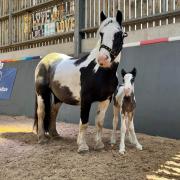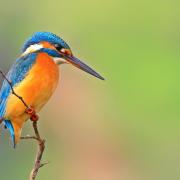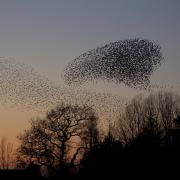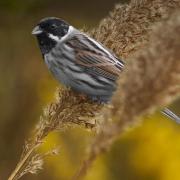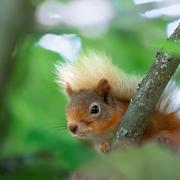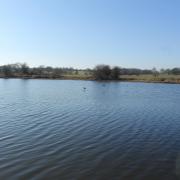Snakes aren't everyone's favourite animal. Rodger McPhail from Carnforth explains why he has had lifelong fascination
If you walk the moors and fells of Lancashire or Cumbria on a warm spring day there is a chance that you might see an adder. Whether the experience is exciting and interesting or shocking and traumatic rather depends on your attitude to snakes. Either way, you are likely to remember it for a long time. Adders are not large snakes - adults are usually around two feet long, but they have a huge presence.
Personally, I have always found adders irresistible. Four years ago I was delighted to discover a colony of them on the moors of Bowland near my home. Since then I have taken every opportunity to study and photograph them. Adders can be found in a variety of habitats, from sand dunes to high moorland. Their main requirements are freedom from disturbance, suitable high, dry banks for hibernating and lower, wetter terrain for hunting. A snake seen on a Lancashire moor is almost certain to be an adder. Grass snakes are scarce this far north.
Unfortunately, many people are so preoccupied with the fact that the adder is venomous that they cannot appreciate the grace and beauty of this much maligned creature. The truth is, that in spite of their fearsome reputation, adders are not at all aggressive and unless you try to pick one up you are highly unlikely to get bitten. To put the danger into perspective no-one in Britain has died from an adder bite for over 30 years. In the same time-span hundreds have died from bee stings and lightning strikes.
The best time to look for adders is on mild days in early spring when they first venture out from hibernation. South facing banks with a thick cover of dead bracken are favoured hibernation sites. Sometimes several snakes can be seen basking together.
Basking is of huge importance to adders; they are like living solar panels and get a lot of their energy directly from the sun. In tropical regions most snakes lay eggs that are incubated by the hot climate. In northern Europe this method is less reliable, so our grass snake lays its eggs in rotting vegetation to provide the necessary warmth.
The adder goes one step further by giving birth to live young. Pregnant females bask in the sun’s rays to incubate their growing babies. This has enabled Vipera Berus to range further north than any other reptile. They are even found inside the Arctic Circle so can take Lancashire winters in their stride - if snakes can be said to have a stride!
Adders never use more energy than is absolutely necessary and their metabolism is so efficient that between six and ten voles a year are all they require. They use the warmth of the sun to bring their body up to working temperature, to build up sperm for the mating season, to digest their food and to incubate their offspring.
Adders are unusual snakes in that they exhibit a great variety of background colours from silvery white to black. Their markings, particularly on the head and neck, are as unique as a human fingerprint and it is possible to recognise individual snakes year after year.
Mating takes place in April and early May. The females give off a pheromone that attracts ardent suitors. Rival males will indulge in the most spectacular ritualised combats known as the Dance of the Adders. The two contestants rear up side by side and attempt to force each other to the ground. They twist and roll and wrestle with great energy until one capitulates and makes off at high speed, often pursued by the victor.
After mating the snakes disperse and can travel some distance to lower, damper ground to spend the summer hunting. The favoured prey is small mammals but adders will also eat lizards, amphibians and the nestlings of small ground-nesting birds such as pipits, wheatears and skylarks. Snakes are reluctant to waste their venom and small defenceless food items like nestlings and froglets are simply seized and swallowed.
The baby snakes, called neonates, are born in late August and September. They are completely independent from birth and equipped with tiny fangs and venom glands. Many will not eat their first meal until the following spring when emerging froglets provide an abundance of food.
With good feeding the neonates grow quickly and are mature in three or four years. Opinions vary as to how old an adder can live, some sources claim they can survive to be as old as 50 years.
In spite of having a venomous bite, adders are rather vulnerable creatures especially when they first emerge from hibernation. A wide range of predators, from hedgehogs to herons, will eat them. The babies, only the size of earthworms, have even more enemies.
The biggest threat to adders in Britain is man. Not many people will kill a snake on sight these days but loss of habitat is a serious problem. There has been some concern recently that adder populations are becoming too fragmented and that inbreeding could be resulting in congenital weaknesses. Herpetologists are testing adder DNA in some areas and considering moving snakes about to introduce new blood.
Adders may not have the immediate appeal of dormice, otters or red squirrels but there is a growing concern for their welfare. More and more people are appreciating them for their grace and perfection. Long may our forays on to the moors of Lancashire be enlivened by the exciting, and slightly scary, sight of a coiled adder.
Rodger’s book The Secret Life of Adders is out now, priced �14,99. If you want to review the book for our website, claim a free copy by emailing vijay.arogyasami@archant.co.uk.
One name will be chosen at random.
And if you have seen adders while out walking in Lancashire upload your picture below



